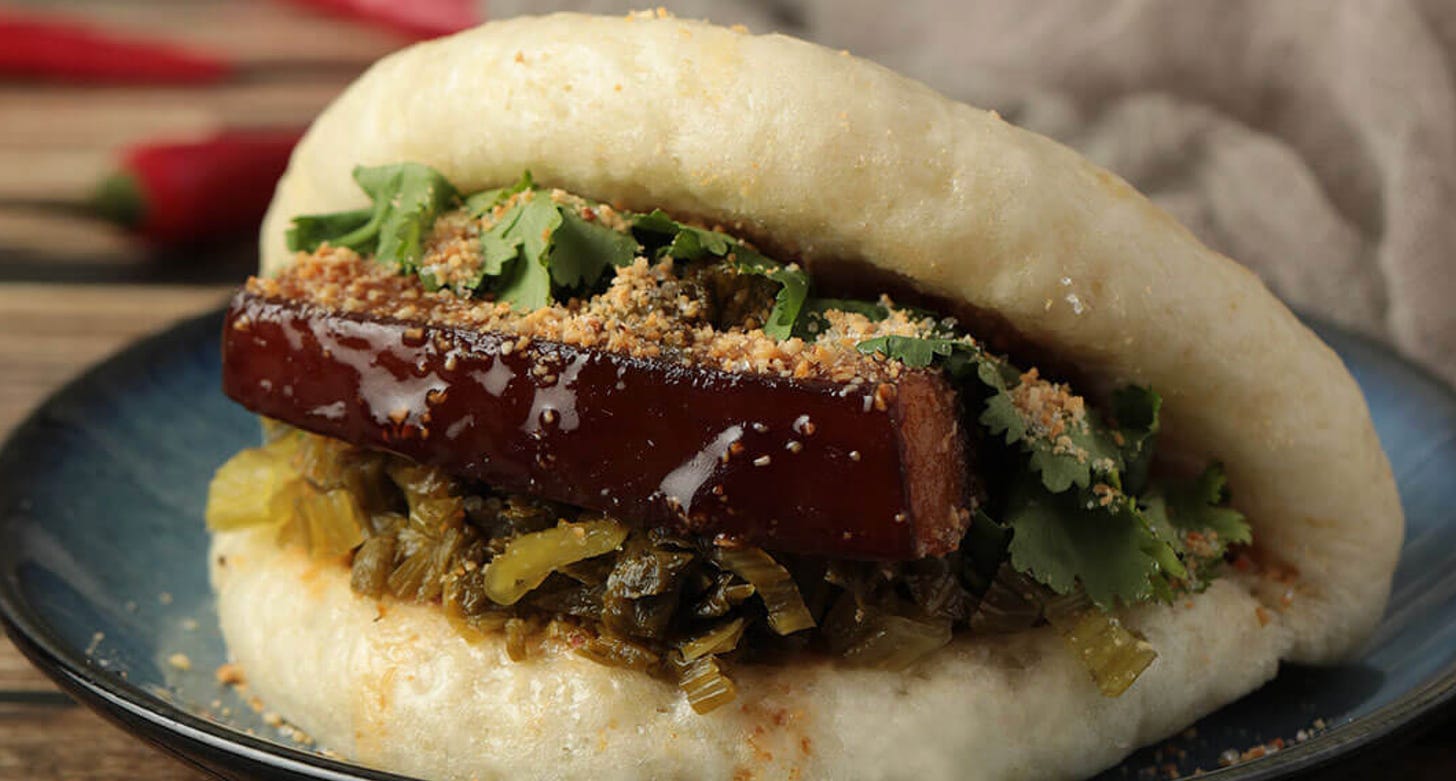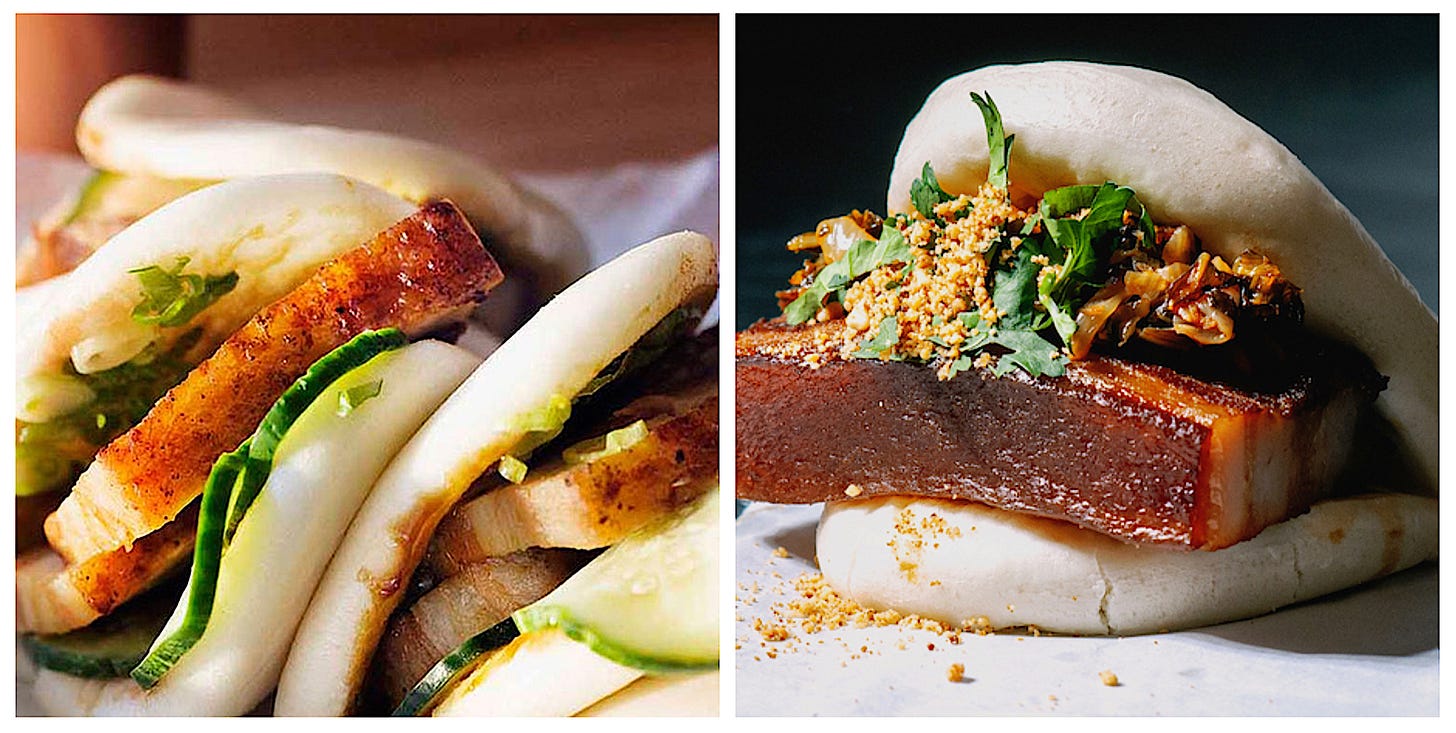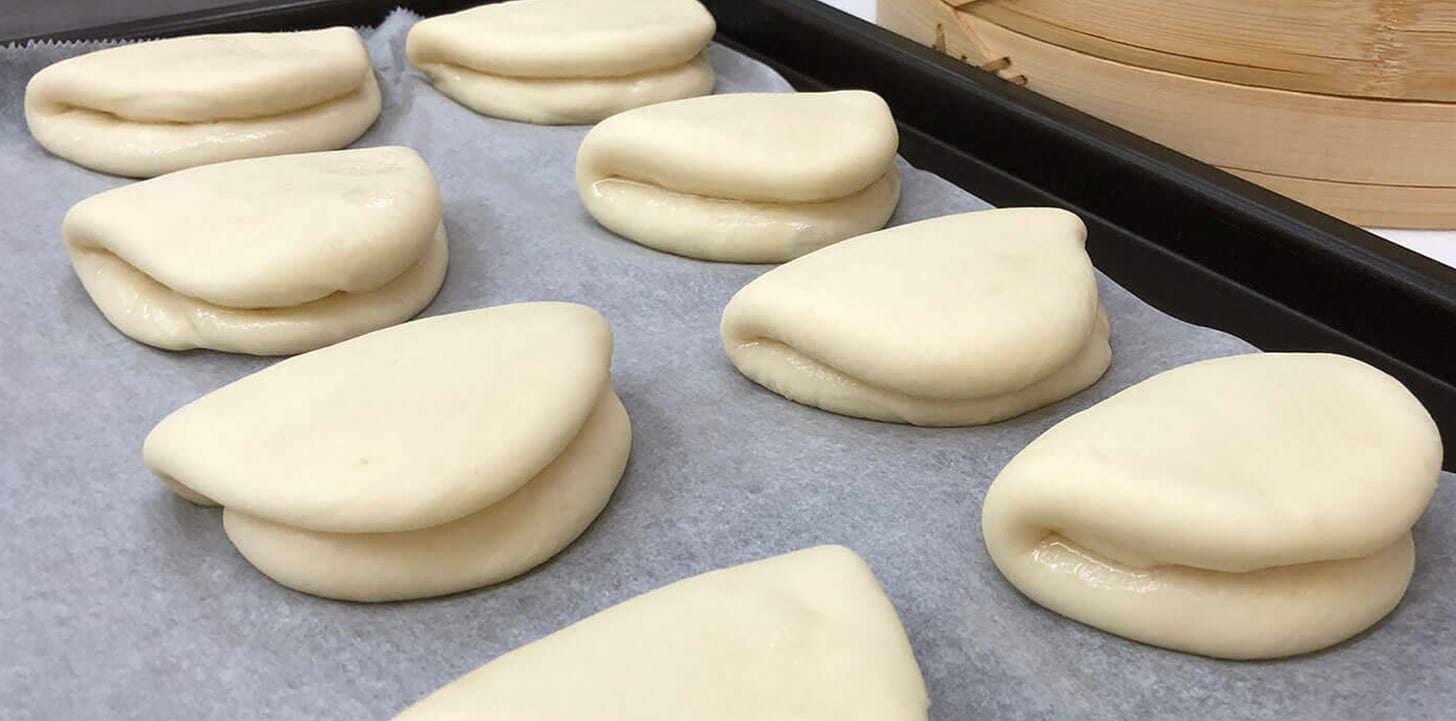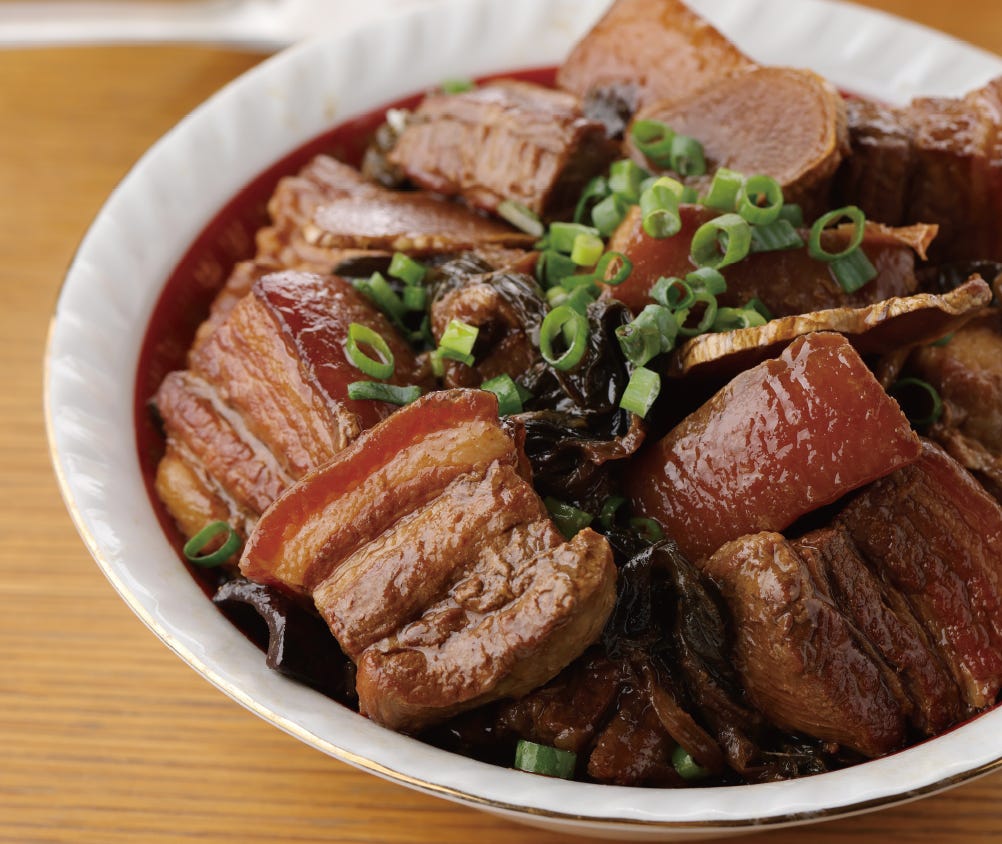Notable Sandwiches #76: Gua Bao
An oral history of the world's best pork buns
Welcome back to Notable Sandwiches, the feature where we trip merrily through the bizarre and mutable document that is Wikipedia’s List of Notable Sandwiches, in alphabetical order. This week, the iconic Taiwanese pork bun: gua bao.
During the first decade of the 21st century, few dishes captured the imaginations and appetites of New Yorkers quite like Momofuku’s pork buns. As owner and chef David Chang’s culinary empire and celebrity grew—more and more restaurants, TV shows, books, magazines, podcasts—the pork buns were there every step of the way. And I, like most American diners, had little idea that not only did Chang not invent the dish, but its origins goes back centuries.
This is a column about gua bao, which Wikipedia describes as a “Fujianese sandwich consisting of a slice of stewed meat and other condiments sandwiched between flat steamed bread.” But it’s also a column about how this traditional Chinese treat was popularized by Chang, a Korean-American chef, and then reclaimed by a Taiwanese-American rival, Eddie Huang. A case could be made that Chang and Huang are the most famous Asian-American cooks of the 21st Century. For Chang, that’s primarily on account of the Momofuku empire. In Huang’s case, success in the food world led to the best-selling memoir, Fresh Off The Boat, which became the blockbuster ABC sitcom of the same name.
In researching, and talking to friends and experts, I realized that the best way to tell this story was through the words of the protagonists, critics, and authorities themselves. I drew from both chef’s memoirs (as well as a conversation between the pair on David Chang’s podcast), the Momofuku cookbook, restaurant reviews, a terrific article on the gua bao by Karissa Chen, and an interview I conducted with Chelsea Tsai, a Taiwanese cooking teacher and founder of Cookinn Taiwan, who was extremely gracious in giving me the recipe for Gua Bao from her upcoming cookbook, Taste Taiwan. (The sources for each of the quotes are hyperlinked.)
Think of this as an imaginary conversation, or overheard oral history of a sandwich whose history is worth celebrating.
In 2003, 26-year-old David Chang opened Momofuku Noodle Bar in New York’s East Village, a pioneer in the 21st Century Ramen explosion. But even more popular than his noodles were the pork buns. At the time, Eddie Huang was a 21-year-old law-school dropout, sneaker head, and street-ware designer living a few blocks from Momofuku.
Eddie Huang: David Chang is the chef who unwittingly popularized a bastardized version of Taiwanese gua bao.
Rob Patronite and Robin Raisfeld, New York magazine: David Chang never claimed to have invented the steamed pork bun. That honor goes to Zhuge Liang, the Chinese military strategist who, legend has it, created the mantou (one of many steamed breads found throughout Asia) to appease the angry river gods who blocked his army’s passage almost two millennia ago.
Chelsea Tsai, interviewed by me [November 9]: Bao has a history of several thousand years in Chinese cuisine, and gua bao, like many Taiwanese snacks (such as Xiaolong bao), was originally brought to Taiwan by Han Chinese immigrants from Fujian, but it has flourished and become a representative of Taiwanese cuisine in Taiwan.
David Chang: One morning I had this simple idea to serve a pork bun—pork belly, hoisin, pickles, steamed bread—as an accompaniment to our ramen, and then we sold a thousand of them in a week. It's an addictive feeling.
Alan Richman, GQ: Many of the best dishes at Chang’s restaurants are inspired adaptations of the creations of other chefs.
Eddie Huang: It came about because he'd eat at Oriental Garden in Chinatown. It's a great Cantonese restaurant that Chinese people go to for weddings and birthdays because it's expensive, but some chefs go to on the regular because, well, they can. Chang would go there and get the “Peking duck.”
David Chang: In the early days of my relationship with Oriental Garden—the restaurant in Manhattan's Chinatown where I've eaten more meals than anywhere else on the planet—I'd always order the Peking duck, which the restaurant serves with folded-over steamed buns with fluted edges, an inauthentic improvement on the more common accompaniment of scallion pancakes.
Eddie Huang: This story is ludicrous on a number of levels. You have this “chef” ordering Peking duck at a Cantonese restaurant that serves the duck in gua bao. Peking duck is served in pancakes, not baos, for a number of reasons. You eat the skin in the pancake so that you get the texture of the skin, the body of the hoisin, the sharpness of scallions, and the thin starch from pancakes. Then you eat the actual meat solo to taste the flavor and make soup with the bones. Any official Peking duck restaurant does it that way. I'm all for innovation, cereal milk, and the evolution of a dish, but it needs to be intended. Serving “Peking” duck in baos is just plain lazy.
David Chang: They were an eleventh-hour addition to the menu. Almost a mistake. No one thought they were a good idea or that anyone would want to eat pork belly sandwiches.
Eddie Huang: It's a great idea that blew up and gained Chang notoriety as the man in New York. To this day, publications like New York magazine still credit Chang for introducing New York to the gua bao.
David Chang: If Momofuku is “famous” for something, it's these steamed pork buns.
The Sword and the Sandwich is a newsletter about deadly serious extremism and serious sandwiches. Please consider supporting this work with a paid subscription:
Peter Meehan, New York Times: Do not pass go with trying [Momofuku’s] pork buns, oblong patties of steamed Chinese bun dough, smeared with a smidge of hoisin sauce, that are folded around thick, meltingly tender chunks of fatty heirloom pork ($8; two to an order). They are equal parts pulled pork sandwich and char siu bao and blasphemously better than either. You may want both buns to yourself.
Karissa Chen, Resy: The first time I had Momofuku’s pork buns, I was hungover. Noodle soup long being my hangover cure, I decided to finally check out Momofuku Noodle Bar, then in its second year. Looking over the menu, I spied the pork buns and, recalling there seemed to be some chatter around them, I tacked it onto our order. I expected a twist on something distinctively Japanese, it being a ramen shop. So when the server put the plate down in front of me, and I saw the hoisin-doused pork belly enveloped in pillowy white bread, I was confused. This, I thought, is a gua bao.
Eddie Huang: I went, I lined up at Momofuku, because I used to live on 12th and 3rd Ave., so I went as soon as it opened, and I was really excited. I remember trying it, and I was like, “This is very good.” I remember talking to the guy who was working there, and I was like, “Yo, you guys aren’t going to put the tofu crisp in here? Why is the sauce different?” And he was like, “What do you mean? It’s always been this sauce.”
Chelsea Tsai: The classic Taiwanese gua bao typically consists of steamed gua bao bun, braised pork belly seasoned with soy sauce and sugar, pickled mustard greens, ground peanuts with sugar, and cilantro. As the gua bao bun is open-faced, chefs can get creative with various fillings.
David Chang: I had never been to Taipei, and before Noodle Bar had opened up, there was no Flickr, there was no website where you could see photographs from Taipei. I didn’t even know how to pronounce it properly.
Eddie Huang: I continued to eat at Noodle Bar a lot, because it was the best pork bun you could get in America…But it started to eat at me, because people didn’t know where it was from.
David Chang: Are they good? They are. Are they something that sprang from our collective imagination like Athena out of Zeus's forehead? Hell no. They're just our take on a pretty common Asian food formula: steamed bread + tasty meat = good eating.
Eddie Huang: I was mad, but I respected the hustle. The only way to get even was to set up shop myself. I thank David. Just like he came up on gua bao, I jumped off his success and brought the title home. A Taiwanese kid makes the best gua bao in New York just like it should be. “It's my island!”—crazy dude in Braveheart.
David Chang: I got into the whole steamed bread thing when I stayed in Beijing. I ate char siu bao—steamed buns stuffed with dark, sweet roast pork-morning, noon, and night from vendors on the street who did nothing but satisfy that city's voracious appetite for steamed buns.
Chelsea Tsai: In Taiwanese, Gua means to cut, and Bao refers to steamed buns, so Gua Bao literally means cutting the steamed bun in half and then stuffing it. Because its form is similar to that of an American hamburger, it began to be marketed globally as the “Taiwanese Hamburger.” However, in Taiwan, it is still referred to as gua bao.
Karissa Chen: In Taiwan you’re more likely to find gua bao sold from carts at night markets than at sit-down establishments. A good gua bao is juicy, brimming with a diversity of flavors and textures: The bun is soft yet not soggy; the fatty meat melts in your mouth and the lean meat is never fibrous; the varied acidity, salinity, and sweetness of the peanut and pickles brighten and balance the rich braise; and I’m told (because I always ask for my gua bao sans cilantro) the cilantro adds a freshness that brings everything together.
Eddie Huang: Growing up, I never really liked char siu bao, but it was always the number-one item among gwai lo. The big white buns baos-filled with barbecued pork-char sui-were familiar and translated well to Americans. I figured baos would be the perfect bridge. They were an obscure, traditional, ambulatory Taiwanese dish with characteristics that Americans would understand. The bread gave people enough of a pole to hang on to and allowed me to put whatever I wanted between those lily-white baos. Plus, it was kinda cool making baos since Grandpa originally made his living selling mantou, which uses the same dough as a bao, just shaped differently.
Chelsea Tsai: When making the Gua bao bun, it is directly formed into an oval dough and then folded in half, resembling a tiger's open mouth. When filled with braised pork, it creates the imagery of a “tiger biting the pig.”
Eddie Huang: What I wanted to open was Baohaus, a restaurant that specialized in Taiwanese gua bao. I hardly ate bread, because I liked rice, but I knew that in America, rice would never usurp bread as the starch of choice.
Dwight Garner, New York Times: [Huang] calls the brusque service in his restaurant “Anti-Danny Meyer.” He dislikes Harold McGee’s cerebral quality and Ferran Adrià’s preciosity.
Julia Moskin, New York Times: Mr. Huang has a particular beef with restaurants that dumb down Asian food, or that lower the high standards of flavor and technique that he identifies with his Taiwanese family’s cooking. He also said that exaggerated trash talk is part of the hip-hop culture he was immersed in as a clothing designer, before turning his talents to the kitchen.
Eddie Huang: Without us saying anything, everyone was comparing it to Momofuku, which we wanted to happen. The difference was that we braised our pork.
Dwight Garner, New York Times: [Huang] pokes Momofuku’s David Chang, hipster America’s most venerated chef, labeling him a bastardizer of gua bao. Comparing his pork buns to Mr. Chang’s, he boasts, “Nine out of 10 Asians with taste buds and an I.Q. over 80 like us better.”
David Chang: Had I known, I don’t know if I would have made it… We might have done a pork bun eventually that was going to find a way to respect Taiwanese food culture.
Eddie Huang: What made Bauhaus what it was wasn’t just the food. The food is good, the food is cool, and I love it. But it was that we tied it to history.
Karissa Chen: Chang didn’t set out to borrow something from Taiwanese cuisine—he was a chef playing around, using materials he had at hand, and drawing inspiration from his experiences to create something that he thought was new. That he stumbled across something so similar to an iconic Taiwanese dish rooted in Taiwanese culture is a coincidence. Who can fault him?
Chelsea Tsai’s Gua Bao
Makes 6
Ingredients
STEAMED BUNS
1 cup (140g) all-purpose flour
1/2 cup (60g) cake flour
1/2 teaspoon (3g) instant yeast
4 tsp (20g) sugar
1 tsp (5ml) neutral cooking oil
2/5 cup (100ml) cool water
FILLING
6 pieces braised pork belly (recipe below)
3 tbsp (45g) ground peanuts
4 tsp (20g) sugar
1/3 cup (80g) pickled mustard greens, rinsed and chopped 1/2 (10g) red chili pepper, sliced
A small bunch of cilantro leaves
Instructions
MAKE STEAMED BUNS
In a mixing bowl, combine all-purpose flour, cake flour, instant yeast, sugar, and oil. Gradually add cool water while stirring until the dough comes together.
Transfer the dough to a clean surface and knead until smooth and round. Take your time and ensure firmness.
Divide the dough into 6 equal portions (50g each) and work each one into an egg shape.
Use a rolling pin to flatten each dough portion into an elongated oval shape, approximately 5mm thick.
Brush a thin layer of vegetable oil on one side of each dough oval. Fold the ovals in half, creating fan-like shapes with the oiled sides facing in to prevent sticking during steaming
Place the shaped buns in a warm, 30-35°C environment for 30-60 minutes to rise. The dough should double in thickness and feel airy when touched.
Arrange the buns in a steamer and steam for 10 minutes
SERVE
Heat a wok over medium heat, then add cooking oil. Saute the pickled mustard greens and chili pepper until fragrant. Season with soy sauce and sugar, then set aside
In a small bowl, mix the ground peanuts and sugar.
Open a steamed bun, and place a slice of braised pork belly inside. Garnish with sauteed pickled mustard greens around peanuts with sugar, and a sprinkle of fresh cilantro leaves. Repeat with the remaining buns and relish each mouthwatering bite
Mom's Braised Pork Belly
jia-cháng kòu-ròu
Serves 4-6
Ingredients
3 tbsp (45ml) cooking oil
2 scallions, cut into 2-inch (5cm) pieces
20 ounces (600g) pork belly, skin-on, sliced into large slabs
1-inch (2.5cm, 10g) ginger, sliced
4 tsp (20g) rock sugar
1 whole star anise
1 tsp (5g) cinnamon, or 1/2 cinnamon stick
1/2 cup plus 1 tbsp (95ml) aged soy sauce
1/2 cup plus 1 tbsp (95ml) rice wine
4 cups (960ml) water
1 tsp (2g) white pepper
Instructions
Heat a wok over medium heat, then add cooking oil. Sauté the scallions until they become fragrant and golden brown. This step is important as it forms the flavorful base of the dish.
Push the scallions to one side of the wok and add the pork and ginger slices. Fry the pork until the edges become crispy.
Add rock sugar, star anise, and cinnamon to the wok.
Cook until the sugar caramelizes and coats the pork.Pour in aged soy sauce and allow it to boil, releasing its aromatic flavors
Deglaze the wok with rice wine, then add water and white pepper. Bring the mixture to a boil.
Transfer the mixture to a slow cooker, such as a clay pot
or electric cooker. and simmer for at least 40 minutes. You can also add unshelled boiled eggs or bean curd to braise together.Serve the braised pork hot with steamed rice or use it as a filling for gua bao.











When Momofuku opened its first Sydney restaurant, one reviewer's notes on the gua bao said "lt's like eating a baby."
I'm not entirely sure that's a compliment.